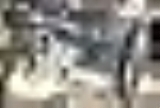
Canon de 75 modèle 1897
Encyclopedia
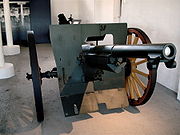


Quick-firing gun
A quick-firing gun is an artillery piece, typically a gun or howitzer, which has several characteristics which taken together mean the weapon can fire at a fast rate...
field artillery
Field artillery
Field artillery is a category of mobile artillery used to support armies in the field. These weapons are specialized for mobility, tactical proficiency, long range, short range and extremely long range target engagement....
piece adopted in March 1898. Its official French designation was: Matériel de 75mm Mle 1897. It was commonly known as the French 75, simply the 75 and Soixante-Quinze (French for 75).
The French 75 is widely regarded as the first modern artillery piece. It was the first field gun
Field gun
A field gun is an artillery piece. Originally the term referred to smaller guns that could accompany a field army on the march and when in combat could be moved about the battlefield in response to changing circumstances, as to opposed guns installed in a fort, or to siege cannon or mortars which...
to include a hydro-pneumatic recoil mechanism, which kept the gun's trail and wheels perfectly still during the firing sequence. Since it did not need to be re-aimed after each shot, the French 75 could deliver fifteen rounds per minute on its target, either shrapnel or high-explosive, up to about 5 miles (8,500 m) away. Its firing rate could even reach 30 rounds per minute, albeit only for a short period of time and with a highly experienced crew. These were rates that contemporary bolt action rifles could not match.
At the opening of World War I, in 1914, the French Army had about 4,000 of these field guns in service. By the end of the war about 12,000 had been produced . It was also in service with the American Expeditionary Forces (AEF), which had been supplied with about 2,000 French 75 field guns. Several thousand were still in use in the French Army at the opening of World War II, updated with new wheels and tires to allow towing by trucks rather than by horses.
It is not to be confused with the Schneider manufactured "Canon de 75mm Mle 1912
Canon de 75 modèle 1912 Schneider
The Canon de 75 modele 1912 Schneider was a French World War I piece of 75 mm artillery, designed and manufactured by Schneider et Cie in Le Creusot. It entered service with the French horse-mounted artillery in 1912 and some were sold to the army of Serbia...
" used by French cavalry and the Serbian army, and its 1914 modification
Canon de 75 modèle 1914 Schneider
The Canon de 75 modele 1914 Schneider was a French World War I piece of 75 mm artillery, designed and manufactured by Schneider et Cie in Le Creusot. Similar to the earlier Canon de 75mm Modele 1912 Schneider and also a derivative of Canon de 75 modèle 1897, it featured a longer barrel and an...
. Although they used the original French 75's ammunition, these privately manufactured Schneider guns were lighter, smaller, and mechanically different.
Development
The forerunner of the French 75 was an experimental 57mm gun which was first assembled in September 1891 at the BourgesBourges
Bourges is a city in central France on the Yèvre river. It is the capital of the department of Cher and also was the capital of the former province of Berry.-History:...
arsenal under the direction of a Captain Sainte-Claire Deville. This 57mm gun took advantage of a number of the most advanced artillery technologies available at the time:
- 1) VieillePaul Marie Eugène VieillePaul Marie Eugène Vieille ,a graduate of Ecole Polytechnique, was a French chemist and the inventor of modern nitrocellulose-based smokeless gunpowder in 1884. The new smokeless powder was three times as powerful as black powder for the same weight and left virtually no residues of combustion...
's smokeless powder, which was invented in 1884. - 2) Self-contained ammunition: the powder charge sat in a brassBrassBrass is an alloy of copper and zinc; the proportions of zinc and copper can be varied to create a range of brasses with varying properties.In comparison, bronze is principally an alloy of copper and tin...
case which also held the shell. - 3) An early hydro-pneumatic short recoil mechanism that was designed by Major Louis Baquet.
- 4) A rotating screw breechBreech-loading weaponA breech-loading weapon is a firearm in which the cartridge or shell is inserted or loaded into a chamber integral to the rear portion of a barrel....
, which soon appeared on the 75mm field gun, built under license from Thorsten NordenfeltThorsten NordenfeltThorsten Nordenfelt , was a Swedish inventor and industrialist.Nordenfelt was born in Örby outside Kinna, Sweden, the son of a colonel. The surname was and is often spelt Nordenfeldt, though Thorsten and his brothers always spelt it Nordenfelt, and the 1881 Census shows it as Nordenfelt...
.
Somewhat earlier, in 1890, General Mathieu, Director of Artillery at the Ministry of War, had been informed that Konrad Haussner, a German engineer working at the Ingolstadt
Ingolstadt
Ingolstadt is a city in the Free State of Bavaria, in the Federal Republic of Germany. It is located along the banks of the Danube River, in the center of Bavaria. As at 31 March 2011, Ingolstadt had 125.407 residents...
arsenal had patented an oil and compressed air long recoil system for field artillery. Furthermore, that after a series of tests made by the firm of Krupp
Krupp
The Krupp family , a prominent 400-year-old German dynasty from Essen, have become famous for their steel production and for their manufacture of ammunition and armaments. The family business, known as Friedrich Krupp AG Hoesch-Krupp, was the largest company in Europe at the beginning of the 20th...
the latter considered manufacturing a new gun incorporating this system. However Krupp finally rejected Haussner's invention due to insoluble technical problems caused by hydraulic fluid leakage. Then Konrad Haussner sold his patents in 1891 to a firm named Gruson which searched for other potential buyers. After reviewing the patent office blueprints in February 1892, the French artillery engineers advised that a gun should be produced without purchasing the Haussner invention. Accordingly, General Mathieu turned to Lt. Colonel Albert Deport, at the time the Director of the Atelier de Construction de Puteaux (APX), and asked him whether he could construct a gun on the general principle of the Haussner long cylinder recoil without infringing the existing patents. This request to proceed, being accepted as feasible, was made formal on 13 July 1892.
It took five more years under the overall leadership of Mathieu's successor, General Deloye, to perfect and finally adopt in March 1898 an improved and final version of the Deport 75mm long-recoil field gun. Various deceptions, some of them linked to the Dreyfus Case
Dreyfus Affair
The Dreyfus affair was a political scandal that divided France in the 1890s and the early 1900s. It involved the conviction for treason in November 1894 of Captain Alfred Dreyfus, a young French artillery officer of Alsatian Jewish descent...
which erupted in 1894, had been implemented by General Deloye and French counter-intelligence to distract German espionage.
The final experimental version of Deport's 75mm field gun had been tested during the summer of 1894 and judged very promising. Extensive trials, however, revealed that it was still prone to hydraulic fluid leakage from the long recoil mechanism. Because it was judged very promising, the Deport 75 was returned to Puteaux arsenal for further improvements. Hydraulic fluid leakage was typical of this experimental phase of artillery development during the 1890s, as Haussner and Krupp had previously experienced.
In December 1894, Lt. Colonel Albert Deport (1846–1929) was passed over for promotion and resigned to join "Chatillon-Commentry", a private armaments firm. Two young military engineers from Ecole Polytechnique
École Polytechnique
The École Polytechnique is a state-run institution of higher education and research in Palaiseau, Essonne, France, near Paris. Polytechnique is renowned for its four year undergraduate/graduate Master's program...
, Captains Etienne Sainte-Claire Deville (1857–1944) and Emile Rimailho (1864–1954), carried on with the project and brought it to fruition in 1896. Their contribution was a leak-proof hydro-pneumatic long recoil mechanism which they named " Frein II " ( Brake # II ). A major progress was the placement of improved silver alloy rings on the freely moving piston which separated the compressed air and the hydraulic fluid inside the main hydro-pneumatic recoil cylinder. These and other modifications achieved the desired result: the long-term retention of hydraulic fluid and compressed air inside the recoil system, even under the worst field conditions. Captain Sainte-Claire Deville also designed important additional features such as a device for piercing the fuzes of shrapnel shells automatically during the firing sequence (an "automatic fuze-setter"), thus determining the desired bursting distance. The independent sight had also been perfected for easy field use by the crews and a nickel-steel shield protected the gunners. The armored caissons were designed to be tilted in order to present the shells horizontally to the crews. The wheel brakes could be swung under each wheel ("abattage") and together with the trail spade they immobilized the gun during firing. The gun was adopted on 28 March 1898 under the official name of "Matériel de 75mm Mle 1897". The public saw it for the first time during the Bastille Day parade of 14 July 1899 but no one then had any idea of the technical progresses that had been achieved.
Description of the hydro-pneumatic recoil mechanism
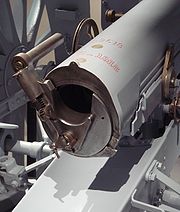
Ammunition

- A 5.3 kilograms (11.7 lb) impact-detonated, thin-walled steel, high-explosive (HE) shell with a time delay fuzeFuzeFuze Beverage, commercially referred to as just Fuze , is a manufacturer of teas and non-carbonated fruit drinks enriched with vitamins. Currently the brand consists of five vitamin-infused lines: Slenderize, Refresh, Tea, Defensify, and Vitalize...
. The delay lasted five hundredths of a second, designed to explode at a man's height after bouncing forward off the ground. A melted explosive called trinitrophenol, picric acidPicric acidPicric acid is the chemical compound formally called 2,4,6-trinitrophenol . This yellow crystalline solid is one of the most acidic phenols. Like other highly nitrated compounds such as TNT, picric acid is an explosive...
, or "Melinite", used since 1888 by French artillery, filled the HE shell. - A 7.24 kilograms (16 lb) time-fuzed shrapnel shell containing 290 lead balls. The balls shot forward when the fuze's timer reached zero, ideally bursting high above the ground and enemy troops. Later, during World War I, several new shells and fuzes were introduced due to the demands of trench warfare, including a boat-tailed shell (with a superior ballistic coefficientBallistic coefficientIn ballistics, the ballistic coefficient of a body is a measure of its ability to overcome air resistance in flight. It is inversely proportional to the negative acceleration—a high number indicates a low negative acceleration. BC is a function of mass, diameter, and drag coefficient...
) which could reach out to 11000 metres (12,029.7 yd). Every shell, whether it be a high-explosive or shrapnel shell, was fixed to a brass case which was automatically ejected when the breech was opened.
Rapid fire capability
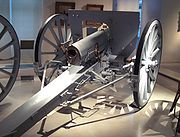
World War I Service
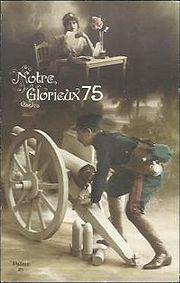
Enlisted men from the countryside took care of the 6 horses that pulled each gun and its first limber. Another 6 horses pulled each additional limber and caisson which were assigned to each gun. A battery included 160 horses, most of them pulling ammunition as well as repair and supply caissons. Over 17,500 Mle 1897 75mm field guns were produced during World War I, over and above the 4,100 French 75's which were already deployed by the French Army in August 1914.
All the essential parts, including the gun's barrel and the oleo-pneumatic recoil mechanisms were manufactured by French State arsenals: Puteaux, Bourges, Châtellerault and St Etienne. A truck-mounted anti-aircraft version of the French 75 was assembled by the automobile firm of De Dion-Bouton
De Dion-Bouton
De Dion-Bouton was a French automobile manufacturer and railcar manufacturer operating from 1883 to 1932. The company was founded by the Marquis Jules-Albert de Dion, Georges Bouton and his brother-in-law Charles Trépardoux....
and adopted in 1913.
The total production of 75mm shells during World War I exceeded 200 million rounds, mostly by private industry. In order to increase shell production from 20,000 rounds per day to 100,000 in 1915, the government turned to civilian contractors and, as a result, shell quality deteriorated. This led to an epidemic of burst barrels which afflicted 75mm artillery during 1915. Colonel Sainte-Claire Deville confronted the crisis (leaky microfissures in the bases of the shells, due to shortcuts in manufacturing) and the problems were corrected. Shell quality was restored by September 1915, but never to the full exacting standards of pre-war manufacture.
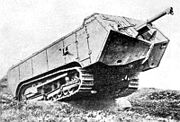
The French 75 gave its best performances during the Battle of the Marne
First Battle of the Marne
The Battle of the Marne was a First World War battle fought between 5 and 12 September 1914. It resulted in an Allied victory against the German Army under Chief of Staff Helmuth von Moltke the Younger. The battle effectively ended the month long German offensive that opened the war and had...
in August–September 1914 and at Verdun
Verdun
Verdun is a city in the Meuse department in Lorraine in north-eastern France. It is a sub-prefecture of the department.Verdun is the biggest city in Meuse, although the capital of the department is the slightly smaller city of Bar-le-Duc.- History :...
in 1916. At the time the contribution of 75mm artillery to these military successes, and thus to the French victories that ensued, was seen as significant. In the case of Verdun, over 1,000 French 75's (250 batteries) were constantly in action, night and day, on the battlefield during a period of nearly nine months. The total consumption of 75mm shells at Verdun during the period February 21 to September 30, 1916, is documented by the public record at Service Historique de l'Armee de Terre to have been in excess of 16 million rounds, or nearly 70% of all shells fired by French artillery during that battle. The French 75 was a devastating anti-personnel weapon against waves of infantry attacking in the open, as at the Marne and Verdun. However its shells were comparatively light and lacked the power to obliterate trench
Trench
A trench is a type of excavation or depression in the ground. Trenches are generally defined by being deeper than they are wide , and by being narrow compared to their length ....
works, concrete bunkers and deeply buried shelters. Thus, with time, the French 75 batteries became routinely used to cut corridors, with high-explosive shells, across the belts of German barbed wire
Barbed wire
Barbed wire, also known as barb wire , is a type of fencing wire constructed with sharp edges or points arranged at intervals along the strand. It is used to construct inexpensive fences and is used atop walls surrounding secured property...
. After 1916, the 75 batteries became the carriers of choice to deliver toxic gas shells, including mustard gas and phosgene
Phosgene
Phosgene is the chemical compound with the formula COCl2. This colorless gas gained infamy as a chemical weapon during World War I. It is also a valued industrial reagent and building block in synthesis of pharmaceuticals and other organic compounds. In low concentrations, its odor resembles...
.
The French Army had to wait until 1917 to receive the modern heavy field artillery (e.g. the 155 mm Schneider howitzer
Canon de 155 C modèle 1917 Schneider
The Canon de 155 C modèle 1917 Schneider, often abbreviated as the C17S, was a French howitzer designed by Schneider et Cie. It was essentially the Canon de 155 C modèle 1915 Schneider fitted with a different breech to use bagged propellant rather than the cartridge cases used by the older howitzer...
and the long range Canon de 155mm GPF
Canon de 155mm GPF
The Canon de 155 Grande Puissance Filloux mle.1917 was a 155 mm cannon used by the French Army during the first half of the 20th century.-History:The gun was designed during World War I by Colonel L.J.F...
) that was virtually absent in 1914. In the meantime it had to do with the old de Bange 155mm converted siege artillery, without recoil brakes, that was inferior in rate of fire and mobility to the more modern and numerous German heavy artillery. The excessive reliance on the 75mm field gun, a doctrine developed by the General Staff during the pre-war years, cost hundreds of thousands of French lives that were lost during the unsuccessful Joffre offensives (Artois/Champagne) in 1915.
World War II Service
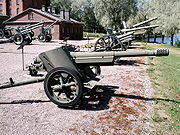
Battle of Westerplatte
The Battle of Westerplatte was the very first battle that took place after Germany invaded Poland and World War II began in Europe. During the first week of September 1939, a Military Transit Depot on the peninsula of Westerplatte, manned by fewer than 200 Polish soldiers, held out for seven days...
, making it the first artillery weapon deployed against German forces during the war.
Some French guns were modernized between the wars, in part to adapt them for anti-tank fire, resulting in the Canon de 75 Mle 1897/33 which fired a high-explosive anti-tank shell. Many were captured by Germany during the Fall of France in 1940, in addition to Polish guns captured in 1939. Over 600, renamed 7.5 cm Pak 97/38
7.5 cm PaK 97/38
The Pak 97/38 was a German anti-tank gun used by the Wehrmacht in World War II. The gun was a combination of the barrel from the French Canon de 75 modèle 1897 and the carriage of the German 5 cm Pak 38....
, were mounted on a 5 cm Pak 38 carriage and put to use by the Wehrmacht in 1942 as an emergency weapon against the Soviet Union's T-34
T-34
The T-34 was a Soviet medium tank produced from 1940 to 1958. Although its armour and armament were surpassed by later tanks of the era, it has been often credited as the most effective, efficient and influential design of World War II...
and KV
Kliment Voroshilov tank
The Kliment Voroshilov tanks were a series of Soviet heavy tanks, named after the Soviet defense commissar and politician Kliment Voroshilov. The KV series were known for their extremely heavy armour protection during the early war, especially during the first year of the invasion of the Soviet...
tanks. Its relatively low velocity and a lack of updated armor-piercing ammunition limited its effectiveness as an anti-tank weapon. When the German 7.5 cm Pak 40 became available in sufficient numbers, most remaining Pak 97/38 pieces were returned to occupied France to reinforce the Atlantic Wall
Atlantic Wall
The Atlantic Wall was an extensive system of coastal fortifications built by Nazi Germany between 1942 and 1944 along the western coast of Europe as a defense against an anticipated Allied invasion of the mainland continent from Great Britain.-History:On March 23, 1942 Führer Directive Number 40...
defenses.
British Service
In 1915 Britain acquired a number of "autocanon de 75 mm mle 1913" anti-aircraft guns, as a stopgap measure while it developed its own anti-aircraft alternatives. They were used in the defence of Britain, usually mounted on de Dion motor lorries using the French mounting which the British referred to as the "Breech Trunnion". Britain also purchased a number of the standard 75 mm guns for which the Coventry Ordnance WorksCoventry Ordnance Works
Coventry Ordnance Works was a British manufacturer of heavy guns, particularly naval artillery. The firm was based in the English city of Coventry.-History:...
developed a mounting, the "Centre Trunnion", for AA use on British vehicles. At the Armistice there were 29 guns in service in Britain.
In 1940, with many British field guns having been lost in the Battle of France
Battle of France
In the Second World War, the Battle of France was the German invasion of France and the Low Countries, beginning on 10 May 1940, which ended the Phoney War. The battle consisted of two main operations. In the first, Fall Gelb , German armoured units pushed through the Ardennes, to cut off and...
, 600 M1897 field guns were purchased from the US Army. The basic, unmodified gun was known in British service as "Ordnance, QF, 75mm Mk 1", although many of the guns were issued to units on converted or updated mountings. They were operated by field artillery and anti-tank units. Some of the guns had their wheels and part of their carriages cut away so that the could be mounted on a pedestal called a "Mounting, 75mm Mk 1". These weapons were employed as light coastal artillery
Coastal artillery
Coastal artillery is the branch of armed forces concerned with operating anti-ship artillery or fixed gun batteries in coastal fortifications....
and were not declared obsolete until March 1945.
US Service
The US ArmyUnited States Army
The United States Army is the main branch of the United States Armed Forces responsible for land-based military operations. It is the largest and oldest established branch of the U.S. military, and is one of seven U.S. uniformed services...
adopted the French 75 mm field gun during World War I and used it extensively in battle. There were 480 American 75mm field gun batteries (over 1,900 guns) on the battlefields of France in November 1918 (Crowell, 1919). The US Army also kept a large inventory of the gun after World War I and used it extensively for training purposes until 1942. The first US artillery shots in action in World War I were fired by Battery C, 6th Field Artillery on October 23, 1917 with a French 75 named "Bridget" which is preserved today at the United States Army Ordnance Museum
United States Army Ordnance Museum
The U.S. Army Ordnance Museum is a museum that is in the process of being re-located to Fort Lee, in Fort Lee, Virginia. Its previous building—at Aberdeen Proving Ground in Aberdeen, Maryland—was closed in September 2010, although many outdoor exhibits are still accessible to the...
. Manufacture of the French 75 by American industry began in the spring of 1918 and quickly built up to an accelerated pace (Crowell, 1919). Carriages were built by Willys-Overland, the hydro-pneumatic recuperators by Singer Manufacturing Co. and Rock Island Arsenal
Rock Island Arsenal
The Rock Island Arsenal comprises , located on Arsenal Island, originally known as Rock Island, on the Mississippi River between the cities of Davenport, Iowa, and Rock Island, Illinois. It lies within the state of Illinois. The island was originally established as a government site in 1816, with...
, the cannon itself by Symington-Anderson and Wisconsin Gun Company. One thousand and fifty (1,050) French 75s were built by American industry during World War I, but only 143 had been shipped to France by 11 November 1918: most American batteries used French-built 75s in action.
During his service with the American Expeditionary Force
American Expeditionary Force
The American Expeditionary Forces or AEF were the United States Armed Forces sent to Europe in World War I. During the United States campaigns in World War I the AEF fought in France alongside British and French allied forces in the last year of the war, against Imperial German forces...
, Captain (and future U.S. President) Harry S. Truman
Harry S. Truman
Harry S. Truman was the 33rd President of the United States . As President Franklin D. Roosevelt's third vice president and the 34th Vice President of the United States , he succeeded to the presidency on April 12, 1945, when President Roosevelt died less than three months after beginning his...
commanded a battery of French 75's.
During the 1930s, many of those were equipped with rubber tires. Others were mounted on a split trail permitting plunging fire (the French 75 M2A1, A2, and A3). M3 Half-Track
M3 Half-track
The Carrier, Personnel Half-track M3 was an armored vehicle used by the United States, the British Empire and the other Allies during World War II and the Cold War. Nearly 43,000 were produced, and supplied to the U.S...
-mounted French 75's (M3 GMC
M3 GMC
The 75 mm Gun Motor Carriage M3 was a United States tank destroyer and self-propelled artillery piece of the Second World War. It was the most numerous tank destroyer in U.S. Army service, during critical battles in North Africa and the Philippines, and continued to be used in more limited...
) were used in the Pacific theater for some time following Pearl Harbor and later during the landing operations in North Africa and Italy. One of the more ingenious uses for the old gun was its mounting in B-25 Mitchell
B-25 Mitchell
The North American B-25 Mitchell was an American twin-engined medium bomber manufactured by North American Aviation. It was used by many Allied air forces, in every theater of World War II, as well as many other air forces after the war ended, and saw service across four decades.The B-25 was named...
bombers to attack Japanese shipping, possibly the inspiration for the production-line-ready XB-25G prototype, which used a more modern gun of US manufacture intended for the purpose. Otherwise, the French 75 was replaced by the more powerful and more versatile U.S. 105mm M101 split-trail Howitzer
M101 howitzer
The 105 mm M2A1 howitzer was the standard light field howitzer for the United States in World War II, seeing action in both European and Pacific theaters. Entering production in 1941, it quickly entered the war against the Imperial Japanese Army in the Pacific, where it gained a reputation...
by 1941.
Field artillery
- canon de 75 mm mle 1897 modifié 1938
- motorized artillery variant with wooden wheels replaced by metallic wheels with tyres, altered shield
Mountain gun
- canon de 75 M(montagne) modèle 1919 SchneiderCanon de 75 M(montagne) modele 1919 SchneiderThe Canon de 75 M modèle 1919 Schneider was a French mountain gun designed as a replacement of the 65 mm mle 1906. The mle 1919 was manufactured by Schneider et Cie and used during World War II. For transport, the gun could be broken down into seven sections. This weapon was used by Brazil,...
- canon de 75 M(montagne) modèle 1928Canon de 75 M(montagne) modele 1928The Canon de 75 M modèle 1928 was a French mountain gun. The guns were also sold to Poland. After 1940, these weapons were used by the Germans as 7.5 cm GebK 283. The French used this weapon to equip the artillery batteries of the 4th Moroccan Mountain Division during 1944 and 1945.-See...
Anti-aircraft
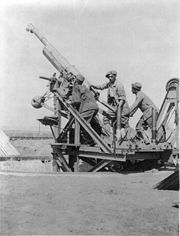
- autocanon de 75 mm mle 1913
- self-propelled anti-aircraft variant, on De Dion-BoutonDe Dion-BoutonDe Dion-Bouton was a French automobile manufacturer and railcar manufacturer operating from 1883 to 1932. The company was founded by the Marquis Jules-Albert de Dion, Georges Bouton and his brother-in-law Charles Trépardoux....
chassis.- canon de 75 mm contre-aéroplanes sur plateforme mle 1915
- static anti-aircraft variant on rotating platform
- canon de 75 mm contre-aéroplanes mle 1917
- anti-aircraft variant on 1-axle trailer with stabilizer legs.
Anti-tank
- Canon de 75 mm mle 1897 modifié 1933
- similar shield and wheels as the standard version, but split-trail carriage allowing 58° traverse. Used in the anti-tank role
External links
- Manual For The Battery Commander. 75-mm Gun. FROM "L'ECOLE DU COMMANDANT DU BATTERIE, I PARTIE, CANON 75", Of THE FRENCH ARTILLERY SCHOOL, OF DECEMBER, 1916, CORRECTED TO MARCH, 1917. Translated to English and republished by US Army War College 1917
- Notes on the French 75-mm Gun. US Army War College. October 1917
- 75 Millimeter Gun Material Model of 1897 M1 (French). Pages 80-93 in "Handbook of artillery : including mobile, anti-aircraft and trench matériel (1920)" United States. Army. Ordnance Dept, May 1920
- United States War Department. TM 9-305 Technical Manual 75-MM Gun Matériel, M1897 and Modifications. 31 March 1941
- List and pictures of WW1 surviving 75mm Mle 1897 guns

